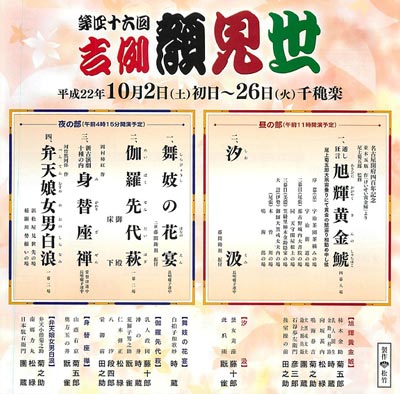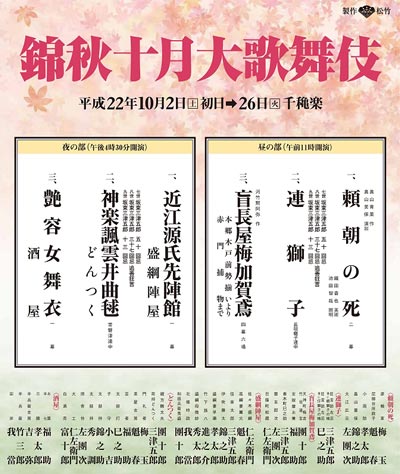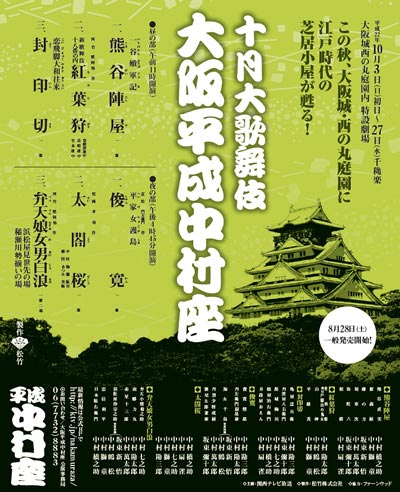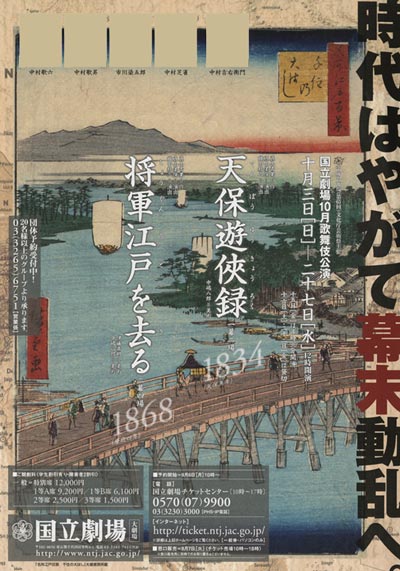| OCTOBER 2010 |
|
2 shows in Nagoya (Misonoza), 2 in ďsaka (Heisei Nakamuraza), 5 in T˘ky˘ (Shinbashi Enbuj˘, National Theatre, Akasaka Act Theater, NHK Hall) and 1 in Ky˘to (Chion'in)!
|
| Misonoza (Nagoya) |  |
| Dates | 2 ~ 26 October 2010 (Kichirei Kaomise Kabuki) |
| MatinÚe | |
| Evening |
Benten Musume Meo no Shiranami
|
| Casting |
Sakata T˘jűr˘, Onoe Kikugor˘, Nakamura Tokiz˘, Nakamura Kanjaku, Onoe Kikunosuke, Sawamura Tanosuke, Onoe Sh˘roku, Ichikawa Danz˘, Band˘ Hikosabur˘ |
| Comments |
46th kaomise at the Misonoza. Namiki Gohei's long-forgotten drama "Keisei Kogane no Shachihoko", which was revived and expanded in January 2010 at the National Theatre is staged under the new title "Asahi-ni Kagayaku Kin no Shachihoko" to commemorate the 400-year anniversary of the establishment of the city of Nagoya. The creation of the town of Nagoya began in 1610, with the beginning of the construction of Nagoya Castle, and the transfer of the entire town of Kiyosu. "Keisei Kogane no Shachihoko" was premiered in the 12th lunar month of 1782 in ďsaka at the Kado no Shibai and successfully produced up to the middle of 3rd lunar month of 1783.
|
 |
| Shinbashi Enbuj˘ (T˘ky˘) |
| Dates | 2 ~ 26 October 2010 (Kinshű Jűgatsu ďkabuki) Autumn Brocade October Grand Kabuki |
| MatinÚe | |
| Evening |
ďmi Genji Senjin Yakata |
| Casting |
Ichikawa Danjűr˘, Kataoka Nizaemon, Nakamura Tomijűr˘, Band˘ Mitsugor˘, Nakamura Baigyoku, Nakamura Kaishun, Kataoka Gat˘, Nakamura Fukusuke, Ichikawa Sadanji, Nakamura Kinnosuke, Kataoka Takatar˘, Kataoka Hidetar˘, Band˘ Takesabur˘, Kamimura Kichiya, Band˘ Minosuke, Kataoka Shinnosuke, Band˘ Shűch˘, Band˘ Kokichi |
| Comments |
|
 |
| Heisei Nakamuraza (ďsaka) | |
| Dates | 3 ~ 27 October 2010 |
| MatinÚe | |
| Evening |
Heike Nyogo no Shima (Shunkan) Taik˘ Zakura Benten Musume Meo no Shiranami
|
| Casting |
Nakamura Kanzabur˘, Nakamura Hashinosuke, Nakamura Senjaku, Band˘ Yajűr˘, Nakamura Shid˘, Nakamura Kantar˘, Nakamura Shichinosuke, Band˘ Shingo, Nakamura Tsurumatsu, Nakamura Mantar˘ |
| Comments |
The Heisei Nakamuraza is in ďsaka for the second time. This time, it is a 2-month project, with four different programs (2 in October and 2 in November).
|
 |
| National Theatre (T˘ky˘) |
| Dates | 3 ~ 27 October 2010 |
| Program | |
| Casting |
Nakamura Kichiemon, Nakamura Shibajaku, Nakamura Karoku, Nakamura Kash˘, Ichikawa Somegor˘ |
| Comments |
|
 |
| Akasaka Act Theater (T˘ky˘) |  |
| Dates | 6 ~ 28 October 2010 |
| Program |
Botantei |
| Casting | |
| Comments |
"Botantei" is a new creation initiated by the star Band˘ Tamasabur˘ and based on the famous Chinese Opera "The Peony Pavilion". The lyrics were written by Yumemakura Baku, who worked in 1991 with Band˘ Tamasabur˘ for the creation of "Y˘kihi". Band˘ Tamasabur˘ shares the stage with performers of Kunqu, one of the oldest forms of Chinese opera which originated in the Suzhou region. This program was premiered in March 2008 at the Minamiza and was also staged in May 2008 in Beijing (China). |
| NHK Hall (T˘ky˘) | |
| Dates | 28 October 2010 (Koten Gein˘ Kansh˘ Kai) |
| Program | |
| Casting |
Kataoka Nizaemon, Kataoka Hidetar˘, Kataoka Takatar˘, Ichikawa Sadanji, Kataoka Sennosuke |
| Comments |
37th edition of Koten Gein˘ Kansh˘ Kai (literally the "Classics Entertainment Appreciation Association"), a yearly performance produced by the National TV network NHK. The program includes one ky˘gen, one Kabuki play, one traditional dance and traditional music.
|
| Chion'in Temple (Ky˘to) | |
| Dates | 27 ~ 28 October 2010 (S˘honzan Chion'in H˘n˘ Kabuki) The Head of the Chion'in Temple Offering Kabuki |
| Program |
Rokuji Raisan to Densh˘ Sh˘my˘ Kurodani Shima no Senzai |
| Casting | |
| Comments |
Original outdoors Kabuki performance, in the precincts of the famous Chion'in temple which is located in Ky˘to. This performance mixes a religious ceremony and two Kabuki dance-dramas. This special program commemorates the Daionki service, which is held once every 50 years. |
|
|
| Contact | Main | Top | Updates | Actors | Plays | Playwrights | Programs | Links | FAQ | Glossary | Chronology | Illustrations | Prints | Characters | Derivatives | Theaters | Coming soon | News |